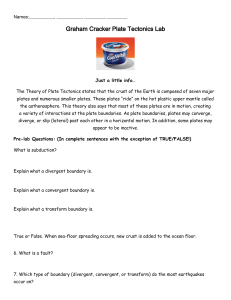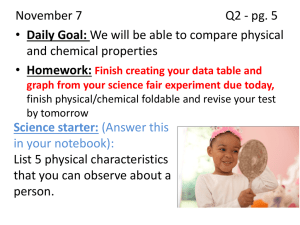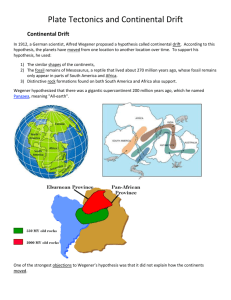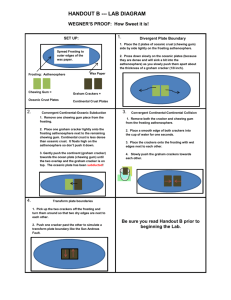Graham Cracker Plate Tectonics Lab
advertisement
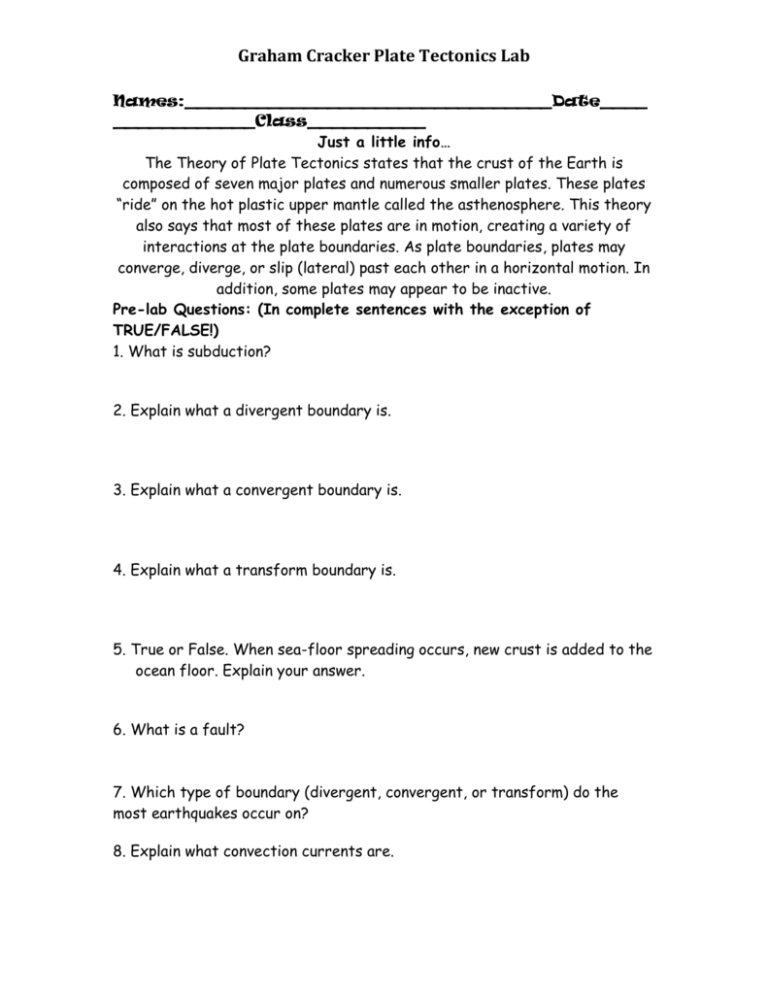
Graham Cracker Plate Tectonics Lab Names:_______________________________Date____ ____________Class__________ Just a little info… The Theory of Plate Tectonics states that the crust of the Earth is composed of seven major plates and numerous smaller plates. These plates “ride” on the hot plastic upper mantle called the asthenosphere. This theory also says that most of these plates are in motion, creating a variety of interactions at the plate boundaries. As plate boundaries, plates may converge, diverge, or slip (lateral) past each other in a horizontal motion. In addition, some plates may appear to be inactive. Pre-lab Questions: (In complete sentences with the exception of TRUE/FALSE!) 1. What is subduction? 2. Explain what a divergent boundary is. 3. Explain what a convergent boundary is. 4. Explain what a transform boundary is. 5. True or False. When sea-floor spreading occurs, new crust is added to the ocean floor. Explain your answer. 6. What is a fault? 7. Which type of boundary (divergent, convergent, or transform) do the most earthquakes occur on? 8. Explain what convection currents are. Graham Cracker Plate Tectonics Lab Activity 1. Procedures- Sea Floor Spreading Break a whole graham cracker into two square pieces by following the perforations on the cracker. Using the knives or spoons, spread a thick layer of cool whip in the center of the paper plate or wax paper. Lay two pieces of the graham cracker side by side on top of the cool whip. To imitate sea-floor spreading, press down lightly on the crackers as you slowly push down and apart in opposite directions. Do not push the crackers more than 1 centimeter apart! Remove the graham crackers from the cool whip. Questions (Complete sentences) 1. What happened to the cool whip between the crackers? 2. What do the graham crackers represent? 3. What does the cool whip represent? FINAL QUESTIONS: ANSWER IN COMPLETE SENTENCES 4. What are plates? 5. What do scientists think causes the movement of Earth’s plates? 6. If oceanic crust collides with continental crust-what will most likely happen? 7. Why do you think it was so important to science when Alfred Wegener and Harry Hess proved their theories of continental drift and sea-floor spreading? Explain your answer in at LEAST 4 sentences! Graham Cracker Plate Tectonics Lab Activity 2. Procedures: Convergent Plate Boundaries- Oceanic and Continental Now lay a WHOLE of graham cracker and the foam board end-to-end (against each other) on top of the cool whip. The graham cracker represents the thin but dense oceanic plate while the foam board represents the thicker but less dense continental plate. Push the two “plate” models slowly toward each other and observe which plate rides up over the other. On the actual surface of the earth, the lower and more dense plate is subducted. Questions (Complete Sentences): 1. Which plate is more dense: continental or oceanic? 2. Which plate will subduct or sink under the other? 3. Why do you suppose oceanic crust is so dense and heavy? FINAL QUESTIONS: ANSWER IN COMPLETE SENTENCES 4. What are plates? 5. What do scientists think causes the movement of Earth’s plates? 6. If oceanic crust collides with continental crust-what will most likely happen? Graham Cracker Plate Tectonics Lab 7. Why do you think it was so important to science when Alfred Wegener and Harry Hess proved their theories of continental drift and seafloor spreading? Explain your answer in at LEAST 4 sentences! Activity 3. Procedures: Convergent Boundaries- Continental Break the graham cracker into four pieces- Each piece of graham cracker represents a continental plate. Dip one end of each of the two graham crackers two centimeters into a cup of water. IMMEDIATELY remove the crackers and lay them end to end on the cool whip with the wet edges nearly touching. Slowly push the two crackers together. Questions: 1. What happens to the wet ends of the graham crackers? 2. In what way do the wet crackers act more like the real crustal plates than the dry crackers? 3. When two continental plates collide in a convergent boundary, they squeeze together to form what? FINAL QUESTIONS: ANSWER IN COMPLETE SENTENCES 4. What are plates? 5. What do scientists think causes the movement of Earth’s plates? 6. If oceanic crust collides with continental crust-what will most likely happen? 7. Why do you think it was so important to science when Alfred Wegener and Harry Hess proved their theories of continental drift and sea-floor spreading? Explain your answer in at LEAST 4 sentences! Graham Cracker Plate Tectonics Lab Activity 4. Procedures: Transform Boundaries Break the graham cracker into two pieces for this part of the lab. Fit the two pieces together side to side on top of the cool whip or frosting on the paper. Place one hand on each of the cracker pieces and push them together by applying steady, moderate pressure. At the same time, also push one of the pieces away from you while pulling the other toward you. If you do this correctly, the cracker should hold while you increase the pushpull pressure, but will finally break from the opposite forces. Questions 1. Why is this movement often described as “horizontal” sliding? 2. What natural disaster occurs often near this type of boundary? FINAL QUESTIONS: ANSWER IN COMPLETE SENTENCES 3. What are plates? 4. What do scientists think causes the movement of Earth’s plates? 5. If oceanic crust collides with continental crust-what will most likely happen? 6. Why do you think it was so important to science when Alfred Wegener and Harry Hess proved their theories of continental drift and seafloor spreading? Explain your answer in at LEAST 4 sentences! Graham Cracker Plate Tectonics Lab Materials (per group) Graham crackers (2 whole crackers) Spoonful of cool whip or frosting (per group) Knives or spoons Wax paper or paper plates Foam Board or marshmallow Cup of water
